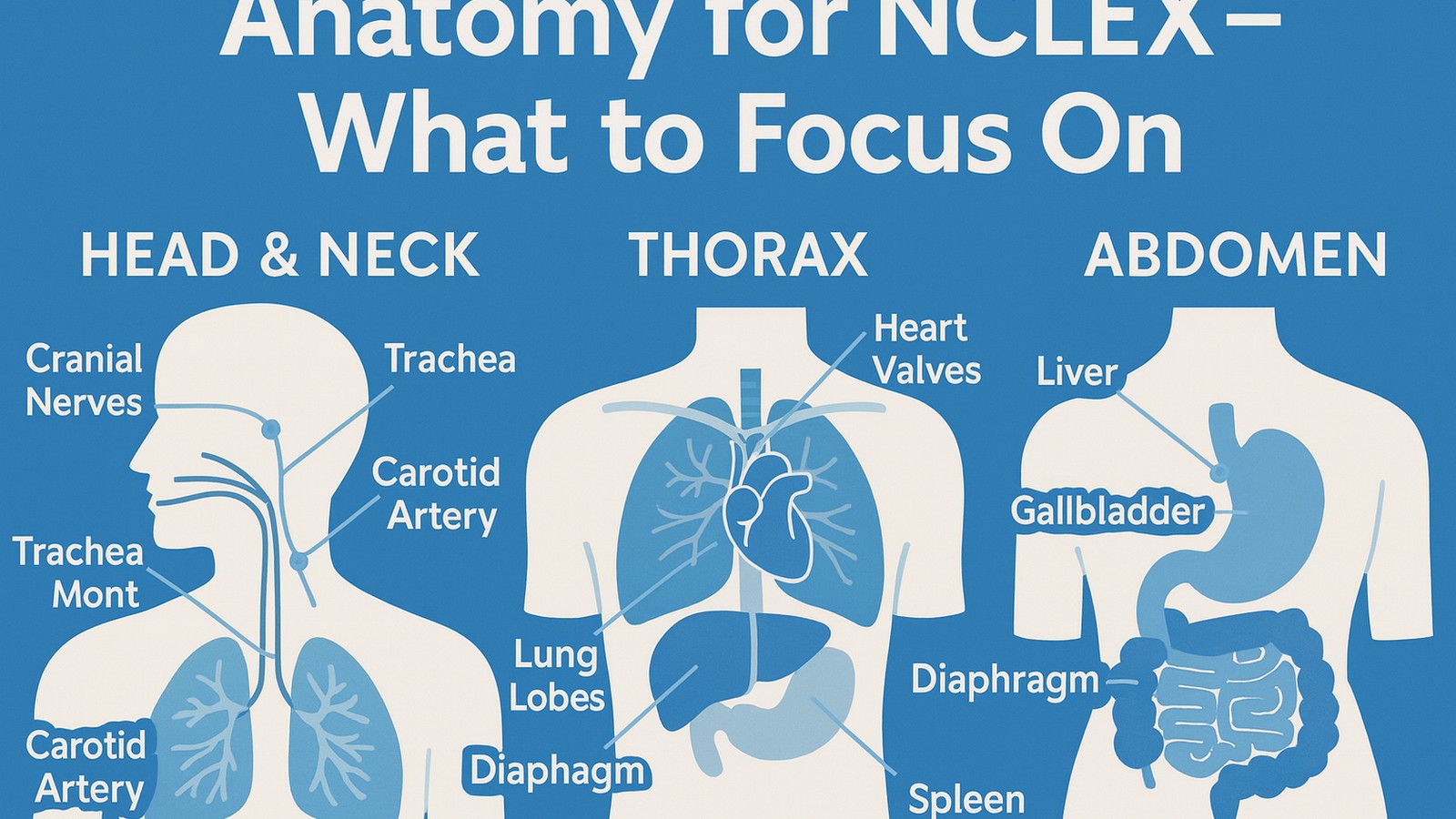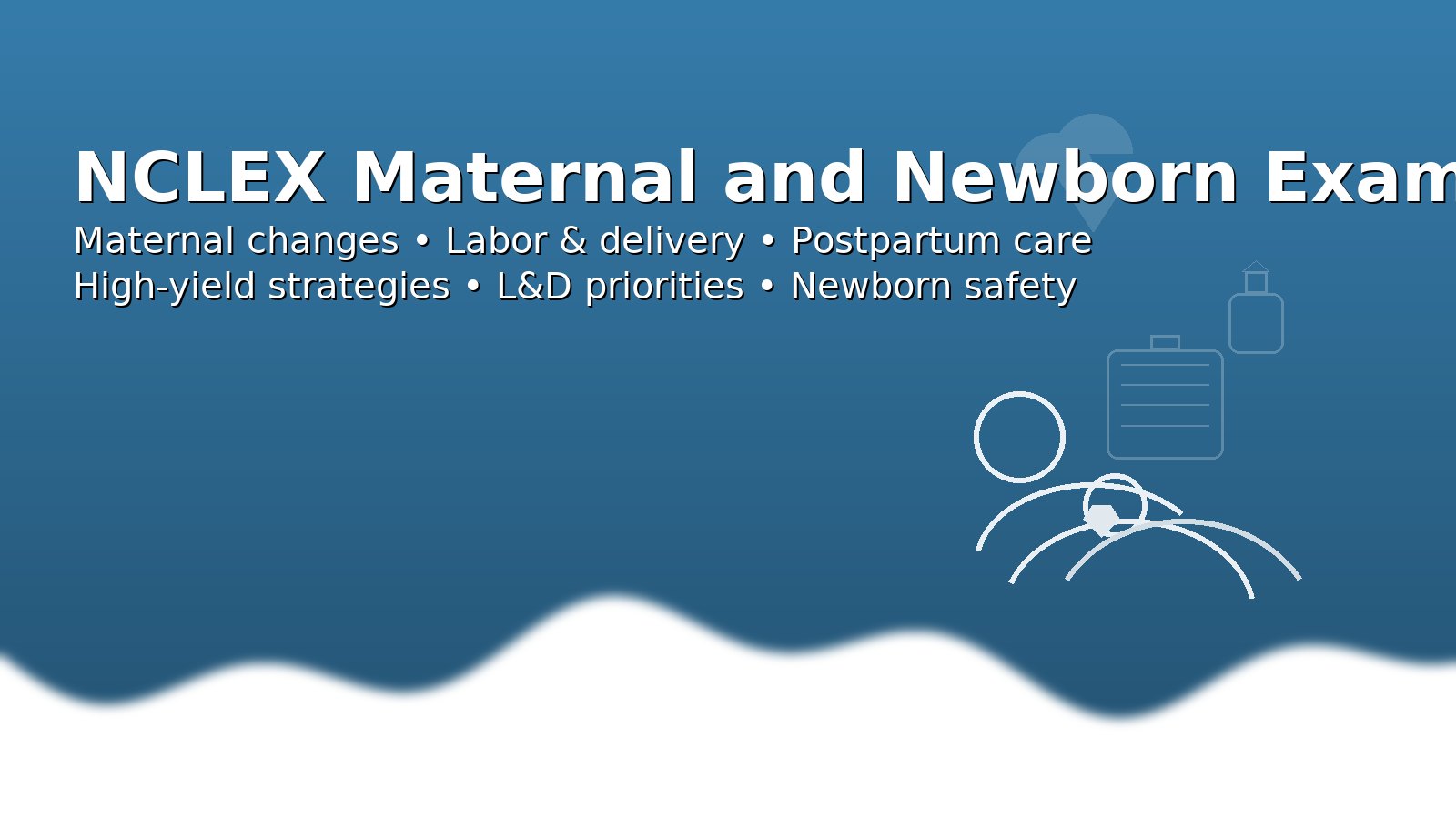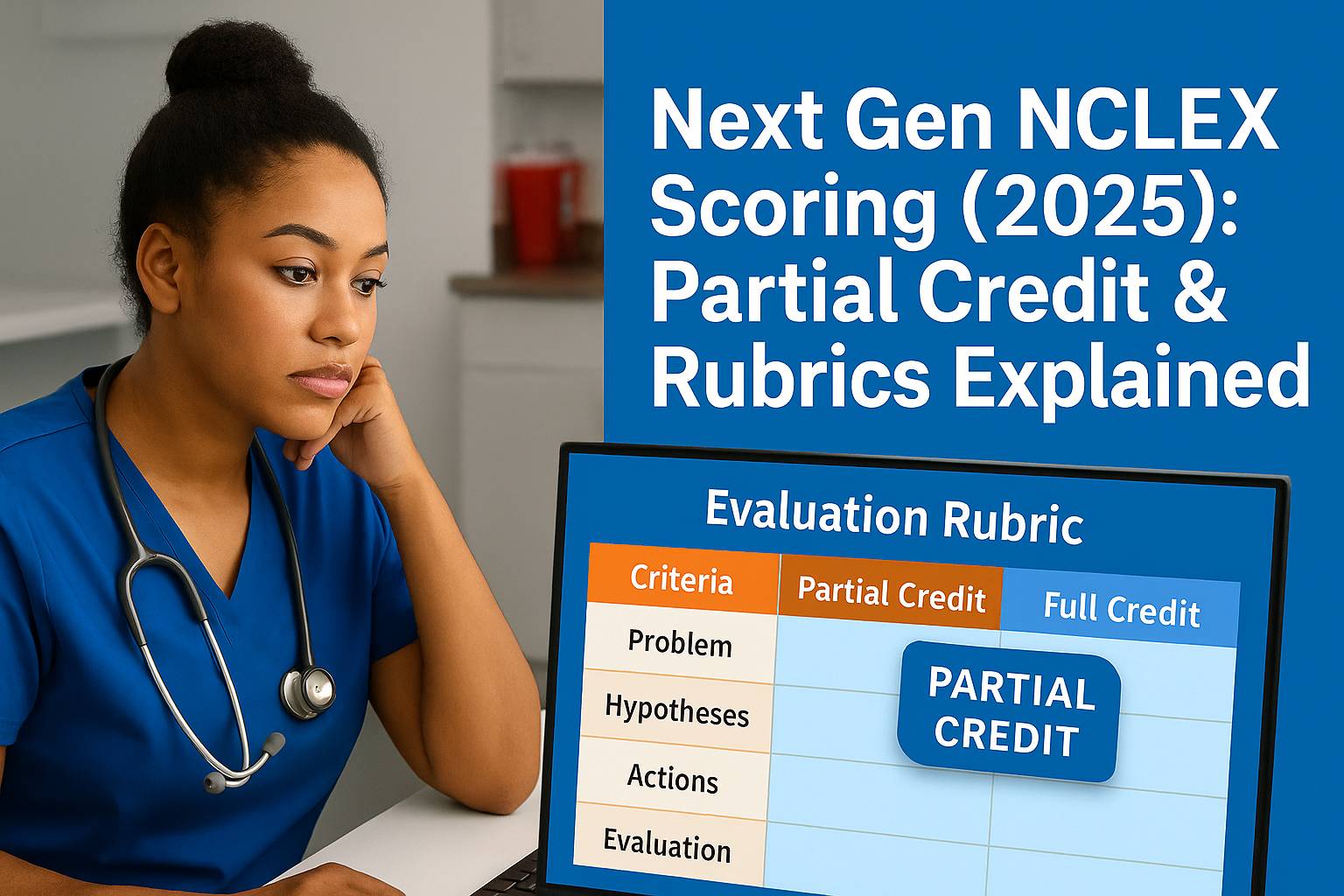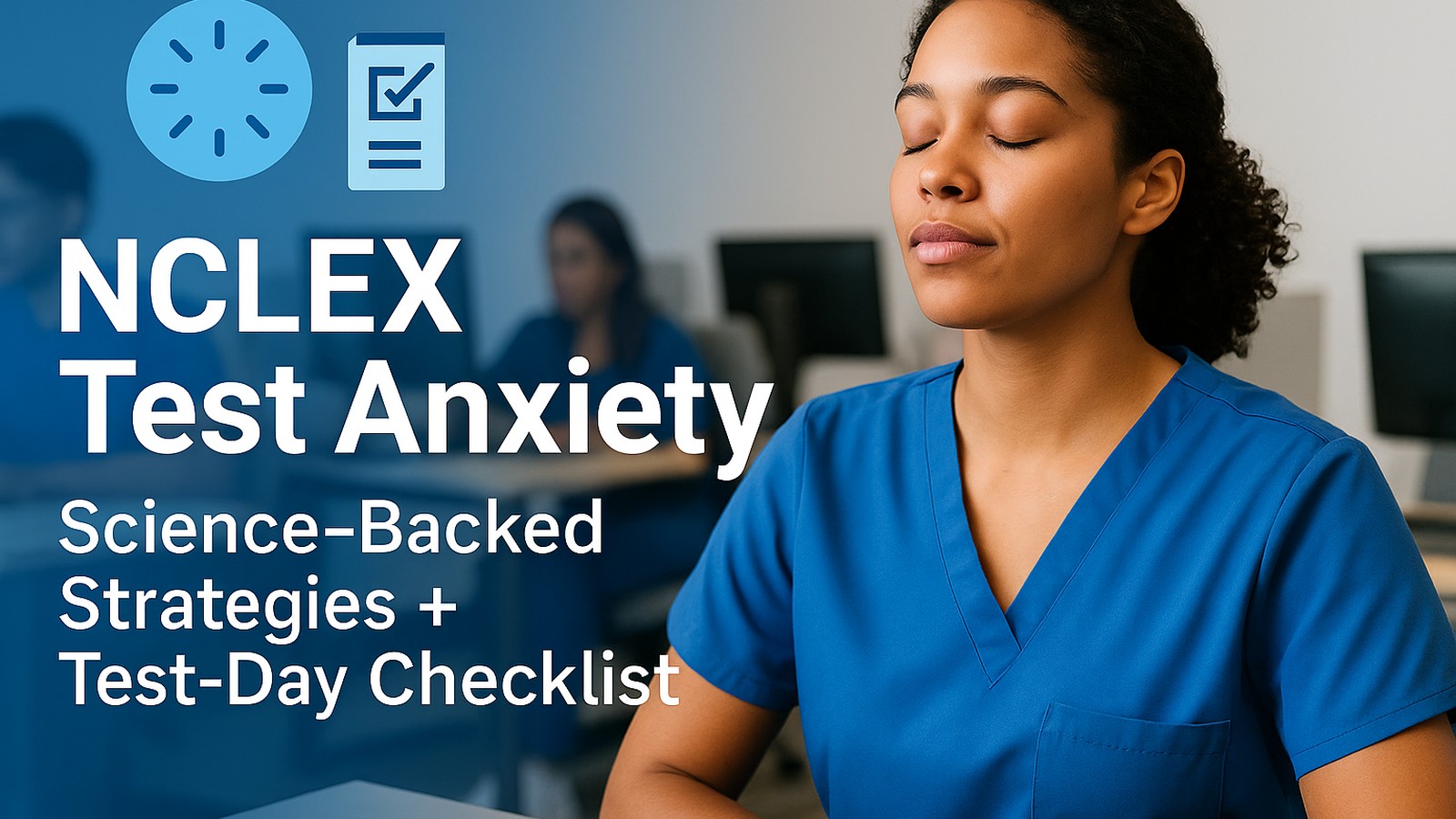Why anatomy for NCLEX matters
The exam doesn’t ask you to memorize every bone or nerve. Anatomy for NCLEX checks whether you can connect structure to safe nursing actions. The key questions are simple:
-
Can you relate anatomy to patient care?
-
Do you understand how systems interact in health and disease?
-
Can you apply anatomy inside pharmacology, pathophysiology, and interventions?
See also: NCLEX Pathophysiology, Pharmacology 2025 , Analysis & Prioritization , Therapeutic Communication
High-yield anatomy topics (by system)
1) Cardiovascular
-
Blood flow through the heart: RA → RV → lungs → LA → LV.
-
Conduction: SA node → AV node → bundle of His → Purkinje fibers.
-
Major vessels: carotids, jugulars, femoral, coronary circulation.
Why NCLEX cares: Links to MI, heart failure, rhythm changes, BP management, perfusion assessments, and medication effects (e.g., β-blockers ↓ HR).
2) Respiratory
-
Alveolar gas exchange: where O₂ enters blood and CO₂ leaves.
-
Ventilation mechanics: diaphragm and intercostals; inhale vs exhale.
-
Upper vs lower airway: suctioning and airway device placement.
Care tie-ins: oxygen devices and targets, positioning (e.g., high-Fowler’s), and suction safety.
3) Nervous system
-
CNS vs PNS; ANS (sympathetic vs parasympathetic).
-
Cranial nerves for bedside checks: vision (II), facial symmetry (VII), gag/swallow (IX/X), hearing (VIII).
-
Reflex arcs for quick neuro screens.
On exam: stroke assessment, seizure care, neuro status changes, safety and aspiration risk.
4) Renal & urinary
-
Nephron anatomy: glomerulus, tubules, and filtration.
-
Urinary flow: kidneys → ureters → bladder → urethra.
-
Key labs: BUN, creatinine, GFR.
Clinical link: fluid balance, diuretic response, AKI/CKD recognition, accurate I&O.
5) Musculoskeletal
-
Major bones and common fracture sites: hip/femur, radius/ulna.
-
Weight-bearing joints and stabilizers.
-
Muscle groups relevant to mobility and rehab.
Care: fall risk, DVT prevention, post-op hip precautions, safe transfers.
6) Digestive (GI)
-
Upper vs lower GI anatomy and roles.
-
Accessory organs: liver, pancreas, gallbladder.
Practice focus: nutrition and absorption, pancreatitis labs, PUD vs IBD, elimination patterns.
7) Reproductive
-
Basic female and male anatomy.
-
Hormonal control of reproduction.
Nursing focus: pregnancy changes, labor, postpartum, lactation, and perineal care.
8) Endocrine & heme/lymph (often integrated)
-
Thyroid and parathyroid placement and function (metabolism, Ca²⁺ balance).
-
Adrenal glands (cortex vs medulla) and stress response.
-
Spleen and lymph nodes for immune function and infection signs.
Why it matters: thyroid storm vs myxedema clues; adrenal crisis risks; lymph node patterns in infection.
How to study anatomy for NCLEX (fast and sticky)
-
Think function → finding: What does this structure do, and what will you see when it fails?
-
Link to first action: position, oxygen, fluids, meds, safety checks.
-
Use one-page visuals: quick diagrams or concept maps per system.
-
Mix practice: Put Anatomy for NCLEX into real scenarios, not trivia lists.
-
Spaced review: revisit tough systems at 24–72 hours to lock them in.
Reinforce with: Isolation Precautions , Delegation & Scope
Mini practice (5 quick items)
1) Which finding best reflects impaired left ventricular function?
A. JVD and ankle edema
B. Crackles and orthopnea ✅
C. Hepatomegaly
D. Dependent edema only
Why: Left-sided failure backs up into lungs → crackles, orthopnea.
2) Suspected CN IX/X impairment—priority check?
A. Pupil reaction
B. Visual fields
C. Gag and swallow ✅
D. Finger-to-nose
Why: CN IX/X protect the airway; assess swallow and gag.
3) Best position to improve V/Q in right-lung pneumonia?
A. Supine
B. Prone only
C. Right side down (good-lung-down per response) ✅
D. Trendelenburg
Why: Positioning can enhance perfusion and oxygenation; follow protocol and patient response.
4) A rising creatinine most directly reflects dysfunction in which nephron site?
A. Loop of Henle
B. Glomerulus (filtration) ✅
C. Collecting duct
D. Distal tubule
Why: Reduced glomerular filtration elevates serum creatinine.
5) Which airway structure matters most for safe oral suction depth?
A. Epiglottis
B. Oropharynx landmarks ✅
C. Tracheal rings
D. Alveoli
Why: Knowing oropharyngeal landmarks prevents trauma and supports safe suction technique.
Quick clinical checklists
-
Cardio: flow path + conduction; watch perfusion and S3.
-
Resp: gas exchange + device fit + positioning.
-
Neuro: CN checks that protect the airway.
-
Renal: nephron map → BUN/Cr/GFR and I&O.
-
MSK: fracture precautions, mobility plan, DVT prevention.
-
Endocrine: thyroid/adrenal red flags tied to vitals and mental status.
Keep going with Nurseclex
-
NCLEX Pathophysiology • Pharmacology 2025 • Analysis & Prioritization • Study Plans • Therapeutic Communication • Signup
(link each to your /homeblogs pages)








